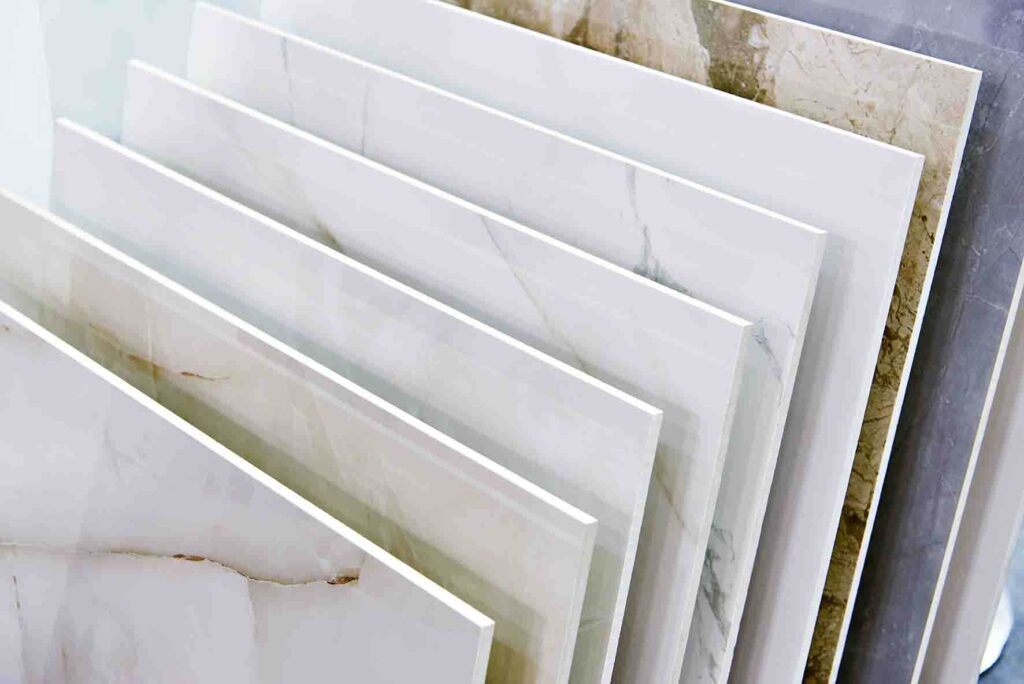Do-it-yourself and home renovation projects are becoming very popular. In fact, 71% of homeowners plan to do a DIY project this year. Doing any renovation is tough, but doing a tile installation can be difficult if you don’t know which material to choose. This article has everything you need to know about porcelain and ceramic tile. We’re going to go over the pros and cons, and what you need, and we’ve even included some project tips. Understanding the difference between the two options will help you make an informed decision. Don’t wait to learn the answer to “Is porcelain or ceramic tile better?” Read on!


Porcelain Tile Pros
One of the main benefits of porcelain for tile flooring is its durability. It’s more resistant to chips, cracks, and scratches than ceramic.
This makes it an ideal product for areas that see a lot of traffic, for example, kitchens, hallways, and even commercial spaces.
It’s also water resistant. It has a low absorption rate which sets it apart from ceramic tiles. This is another reason why it’s great for areas that are exposed to moisture, such as bathrooms and kitchens.
The resistance to water prevents the tiles from cracking or deteriorating due to freeze/tall cycles in outdoor settings. If you’re tiling your back patio, this is a great option.
Another great thing about porcelain is it can be made to mimic a wide range of materials. If you love the look of a natural stone but want the durability of porcelain tile, you can find an option that matches your style. No matter what your aesthetic is, you can bring your vision to life with porcelain tiles.
We briefly talked about how porcelain tile has a low water absorption rate. This also makes it less prone to staining as well, which is another great reason to use it in your kitchen as a countertop or backsplash. It won’t be easily stained from cooking messes or spills.
Disadvantages of Porcelain
When you’re wondering, “Is porcelain or ceramic tile better?” you need to know the two drawbacks of porcelain tiles. It is going to be slightly more expensive due to the manufacturing process in the enhanced qualities.
It’ll also make for a challenging DIY project. Porcelain is denser than ceramic, making it hard to cut and install.
Advantages of Ceramic Tile
Now you may be thinking porcelain has a lot of advantages and benefits, but ceramic does, too. It’s very budget-friendly and you can achieve a stylish look without breaking the bank.
It’s also going to be much easier for you to install yourself. They are lighter and easier to handle, making them more affordable to have installed and easier to do alone.
Ceramic tiles also come in a variety of styles, colors, and patterns just like porcelain does. If you want something modern, classic, or contemporary, you can have ceramic tiles catered to your design preferences.
If you live in a colder climate, ceramic can be a great option for you, as it has a slightly higher heat retention rate. It can make it more comfortable to walk on, especially in the winter months.
Cons of Ceramic
There are a number of drawbacks to be aware of. While ceramic tiles are durable, and will last you a long time, they are not as strong as porcelain.
They’ll be more prone to chips and cracks if you place them in a high-traffic area. It’s better to use ceramic tiles in moderate-trafficked areas and as wall coverings.
These tiles have a higher water absorption rate as well. It’s not recommended that you place these in a wet environment or freezing temperatures.
Price and Cost Factors
The cost difference between porcelain and ceramic tiles can vary based on several factors. The brand, quality, design, size, and location will all contribute to the price. However, there are some general trends that can help provide an overview of the cost distinctions between the types of tile.
Porcelain tiles tend to be more expensive. They could cost between $2 and $30 per square foot.
Higher-end porcelain tiles, ones that have designs, textures, or are larger in size, will be more expensive. Tiles that mimic the look of natural stone and wood will typically be on the higher end of the price spectrum.
Ceramic tiles are going to be a lot less expensive. However, there are some options such as hand-painted tiles and tiles with unique glazes that’ll be much higher than the standard ones. Keep in mind the better the quality, the higher the price and the local market will also affect the cost.

Project Tools
Whether you choose to install porcelain or ceramic tiles, you’re going to need specific tools. For either project, you’ll need safety gear, such as glasses, dust masks, and kneepads.
You’ll need a tape measure and a pencil or chalk. You’ll also need a number of cutting tools, such as a tile cutter, a tile, nipper, and a wet tile saw.
If you decide to install porcelain, you’ll need masonry drill bits for drilling into the porcelain and you’ll also need anchors and screws for attaching the tiles to the wall.
You’ll need tile clips and wedges. This will help you achieve a level surface with the large tiles.
You may also want to purchase a penetrating tile sealer. This will help protect certain types of porous porcelain tiles, but it’s not necessary for every project.
For your ceramic tiling project, you’ll need glass cutters. This will help you make irregular and smaller cuts.
You’ll also want to invest in a drywall joint compound. This is for repairing or smoothing any walls before you install the tile.
It’s important to remember that while you’ll need some of the same tools for both porcelain and ceramic tile insulation, there are specific types and qualities of tools that will affect the ease of use. Typically, the higher the quality of the tool, the easier it’s going to be to use it and the better your project will come out.
To make your life easier later down the road, be sure you have all the tools you need before starting the project. You don’t want to get halfway through installing the tile and realize you’re missing a key tool.

Installing Tile Tips
There are several general installation tips that you need to know. Whether you’re working with porcelain or ceramic, you’ll need to have a layout plan before you start. Dry-lay the tiles without adhesive to visualize the pattern and make any necessary adjustments.
You’ll also need to spend some time preparing the surface. It should be clean, flat, and free of debris.
You’ll also want to ensure the adhesive is set before grouting. This typically takes 24 hours, but check the manufacturer’s guidelines before using the grout.
Porcelain Tips
When you’re installing porcelain tiles, there are a few things you should know. These tiles are typically harder than ceramic tiles. This means you’ll need special tools for cutting such as a wet saw with a diamond blade.
While you may not want to invest in high-quality tools and equipment, it’s key to ensuring your project comes out the way you want it to.
You’ll want to leave expansion gaps around the edge of the insulation area and at transitions between different materials. This is because porcelain tiles can expand and contract with temperature changes. Leaving a little extra room will ensure it’s not damaged later on.
Ceramic Tiling Advice
When you’re installing ceramic tile, it’s vital that you pay attention to the type of tile that you’re using. Some may require a protective layer to be applied. On unglazed tiles, you’ll need an extra seal to prevent any staining.
You’ll also want to be aware of your grout selection. There are some options that are better appropriate for ceramic tiles. Epoxy grout is more resistant to staining and moisture, which is vital when you’re laying ceramic tiles.
Is Porcelain or Ceramic Tile Better: Answered
Choosing between porcelain and ceramic tile is tough. Unfortunately, there isn’t a straightforward answer to, “Is porcelain or ceramic tile better?”. There are so many factors to consider and what’s best for you and your home may not be the best for your neighbor.
Ultimately, both materials have their merits and drawbacks. It’s essential to assess your project’s requirements and weigh the pros and cons before making your decision.
No matter what option you choose, you’ll need the right tools. Check out our shop for all the equipment and tools for your next tiling project.



Post a comment